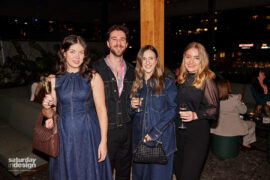Drew Hamilton, Director, pH+ Architects shares his thoughts on the synergies between London and Sydney’s housing landscapes.

February 8th, 2016
Having spent a decade refining our approach to delivering high-quality, residential projects in London’s ever evolving urban fabric, in 2014 we established a second studio in Sydney, to oversee the delivery of our first residential project in Australia. To us, this presented a broader opportunity to extend the practice’s experience gained in London – to Sydney; cites which although 10,000 miles apart, have many similarities, particularly with regards to the broader issue of housing.
Whether in a Sydney coffee shop or London pub, one of the most immediately apparent similarities between Sydney-siders and Londoners, is the constant discussion around the ever-increasing cost of property. Had we come from any other city on the planet, we would no doubt be shocked by the recent increases in property prices in Sydney. However London prices continue to rise at an alarming rate, fuelled, as in Sydney, by both undersupply and speculation from overseas investors. The former in particular, shows no sign of easing with both London and Sydney anticipating population increases by 2031, of 1.4 million and 1.6 million respectively. Whilst this represents a larger proportional increase of 37 percent for Sydney, it poses questions (and opportunities) in both, as to how to successfully accommodate such levels of growth.
In December 2014, NSW Planning & Environment published ‘A Plan for Growing Sydney’. Much like ‘The London Plan’, published by the Greater London Authority in 2011 (updated in March 2015), this sets out a blueprint for accommodating the anticipated growth in Sydney until 2031. One of its primary aims is to create “a city of housing choice with homes that meet our needs and lifestyles” and squarely identifies the need to accelerate housing supply across Sydney, but noting “it is critical not to repeat mistakes of the past – dispersed housing growth in a sprawling and poorly connected city, complicated by unique geographic constraints.”
The plan outlines a range of strategies to deliver the anticipated housing needs. Whilst this includes an element of greenfield development, there is an emphasis on urban renewal around well-connected, existing strategic centres and accelerating new housing in designated ‘infill’ areas and priority precincts. In effect the sprawling, car-based, suburban model has been superseded by the desire to create a more compact and connected city (much like that proposed for London, by Lord Roger’s Urban Task Force’s in 1999). This directly ties in with our own work in London over the past decade, which has been focused around, medium-density, brownfield development in urban areas.
Practicing in London, both as a constrained urban environment and a demanding property market, has required us to use our creativity to maximise the potential of sites. Not only potential in terms of ‘commercial value’ for clients, but also in terms of ‘quality’ for future residents and communities alike. By evolving a creative and contextual approach we have avoided generic responses. Instead developing site-specific designs that respond to both physical and social context, in doing so creating buildings that are each unique and foster a sense of place.
London challenged us to think creatively to address it’s own housing needs. As we walk through our new home, we see similar opportunities, and are excited at the prospect of applying our same ‘process’ driven, contextual approach, to a new city and environment.
This considered approach has given us an excellent record of gaining Planning Approvals in London, and indeed our first project in Sydney was comparatively straightforward, (with approval granted in 6 weeks). As we assess new sites however, Planning Policy in Sydney seems more prescriptive, stipulating, for example, building heights, numbers of storeys and floor space ratios (FSR). Whilst these may provide a degree of certainty, and can be challenged, they may also stifle creativity. London’s approach does not stipulate such criteria, rather it encourages a site-by-site appraisal, requiring a site-specific case to be made in each instance, and as such provides scope to accommodate sound, creative solutions.
We look forward to seeing how the macro policy of accelerating housing supply in Sydney, will translate to the mirco level on individual sites. With both cites set to grow, creative approaches to addressing each city’s housing needs seem more relevant than ever.
pH+ Architects
phplusarchitects.com
Project: Orsman Road
Location: Hackney, London
Description: New build mixed use
Value: £7,000,000
Client: City and Suburban Homes
Status: Complete
Clad in a bronze, with a living ivy façade, rooftop meadows and playful community spaces, gardens and balconies – Orsman Road is a distinct addition to its historic waterside setting. On a site with a history of failed planning applications, pH+ worked with the Borough of Hackney’s policy to create a residential development that could enhance the newly created ‘Green Corridor’ along the Regent’s Canal and maximize biodiversity. The scheme was also required to have a unique and distinct identity and enhance the character of this delicate conservation area.
The development presents a mixed-use offer of housing with an integrated commercial retail space on the ground floor. Sensitively designed to evolve and mature with the passing of time, the building’s copper carapace cladding will weather to a rich brown, reflecting the Regent Canal’s warm muted tones.
Project: Squirries Street
Location: Bethnal Green, London
Description: Roof extension
Value: £300,000
Client: Event
Status: Completed
Two rooftop penthouses are shrouded in living ivy in this site-specific scheme in the London Borough of Hackney. This project is the prototype of an off-site modular housing system that can be delivered on the back of a standard articulated lorry. Stacked apartment components can be wrapped in a ‘skin’ that reflects the surrounding area and can be broken up with balconies and terraces.
The penthouses are made up of two interlocked two-bedroom, two-storey homes, sitting atop an existing fully occupied apartment building. These new units enjoy floor-to-ceiling glazing and unparalleled views across the locale to the City and Canary Wharf. The Ivy on the exterior will continually evolve with growth and the effects of the changing seasons.
INDESIGN is on instagram
Follow @indesignlive
A searchable and comprehensive guide for specifying leading products and their suppliers
Keep up to date with the latest and greatest from our industry BFF's!

From the spark of an idea on the page to the launch of new pieces in a showroom is a journey every aspiring industrial and furnishing designer imagines making.

At the Munarra Centre for Regional Excellence on Yorta Yorta Country in Victoria, ARM Architecture and Milliken use PrintWorks™ technology to translate First Nations narratives into a layered, community-led floorscape.

The Pedrali name is synonymous with fine Italian design and manufacturing. Distributed by Business Interiors in Australia, the collection has been charming design lovers since its launch over 50 years ago. CEO Monica Pedrali explains why…

From WMK, the fourth Space&Co office in the Melbourne CBD is another chapter in the ongoing design narrative of design of modern co-working spaces.

On 6th September 2025, Saturday Indesign went out with a bang at The Albion Rooftop in Melbourne. Sponsored by ABI Interiors, Woodcut and Signorino, the Afterparty was the perfect finale to a day of design, connection and creativity.
The internet never sleeps! Here's the stuff you might have missed

We republish an article in memory of the late architect by UTS, whose Dr Chau Chak Wing Building was Gehry’s first built project in Australia. The internationally revered architect passed away on 5th December.

The Simple Living Passage marks the final project in the Simple World series by Jenchieh Hung + Kulthida Songkittipakdee of HAS design and research, transforming a retail walkway in Hefei into a reflective public space shaped by timber and movement.